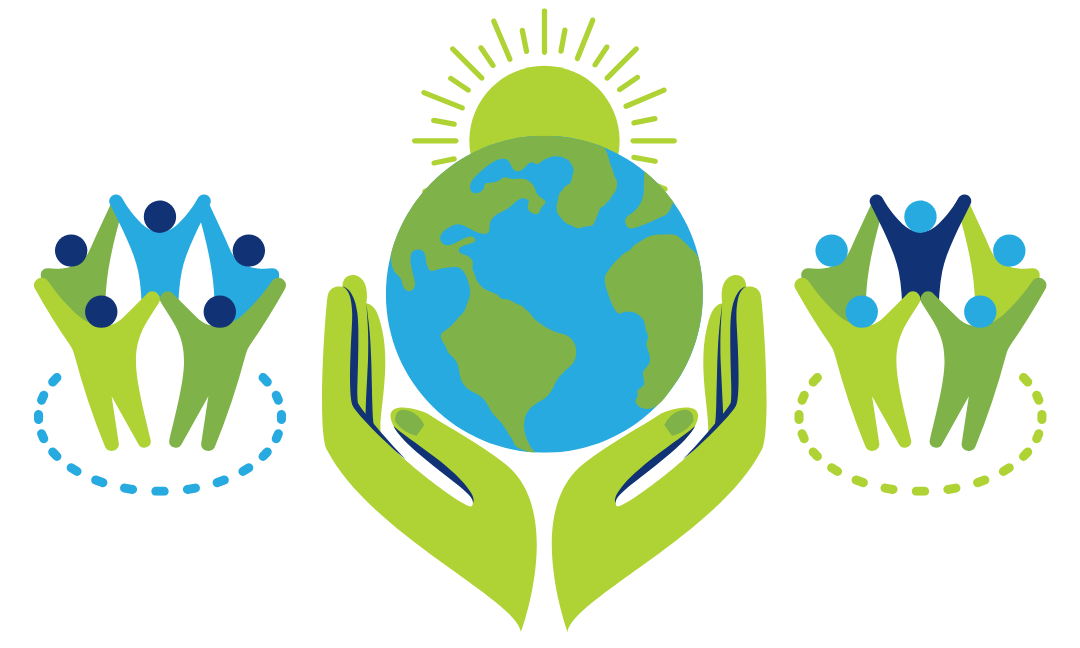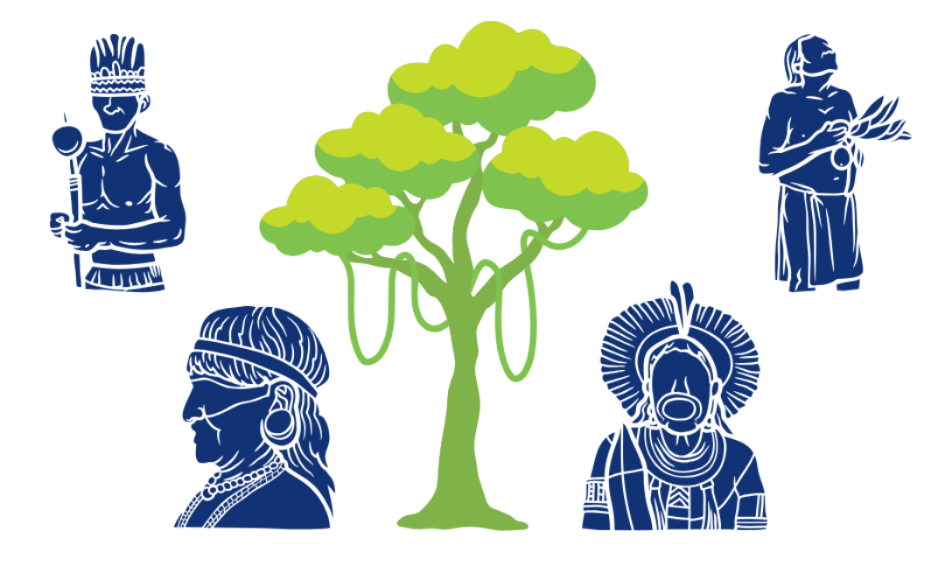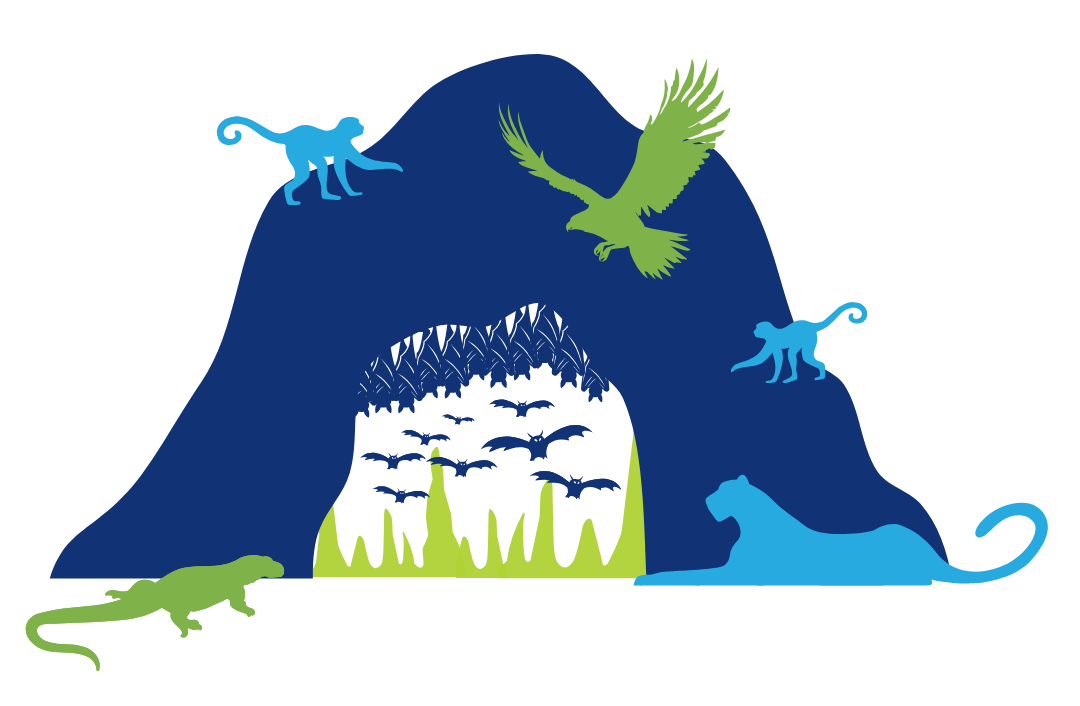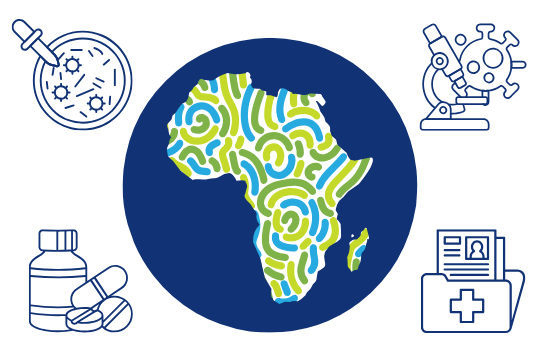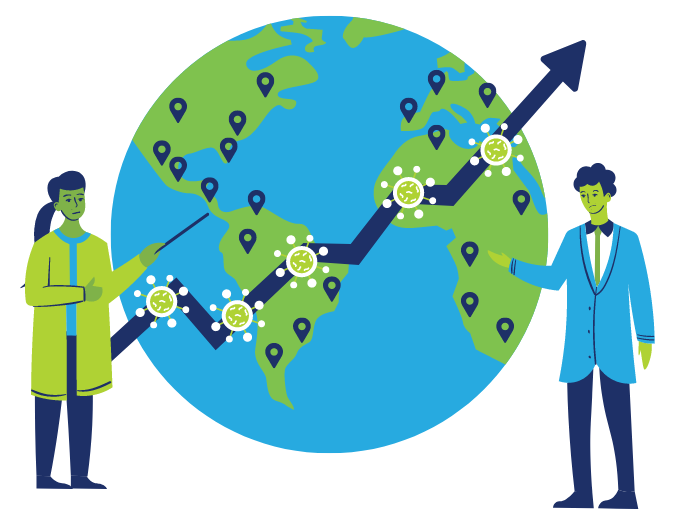
People don’t want to see any more pandemics, notes Nita Madhav, Senior Director of Epidemiology & Modeling at Ginkgo Biosecurity, the biosecurity and public health unit of Ginkgo Bioworks.
The world is collectively traumatized by the horrors of the COVID-19 pandemic, Madhav says in this episode of One World, One Health.
But just because we don’t want to see another pandemic doesn’t mean we won’t get one. The world isn’t doing enough to keep an eye out for the next one, says Madhav.
“Covid was a trial run for something that could be a lot worse. It was really a wakeup call that we need to have better systems in place,” she says.
In any given year, she estimates, there’s a two to three percent chance of a pandemic. But human behavior is raising those odds. More frequent travel is one factor; so is climate change.
What’s she watching most closely right now? H5N1 bird flu. “The more it spreads within mammals that gives it more chances to mutate. As it mutates, as it changes, there is a greater chance it can infect humans. If it gains the ability to spread efficiently from person to person, then it would be hard to stop.”
Listen as Madhav tells One World, One Health about how she measures these risks and what the world needs to be doing to watch for and to reduce these risks.
Maggie Fox 00:01
Hello and welcome to One World, One Health where we take a look at some of the biggest problems facing our world. I’m Maggie Fox. This podcast is brought to you by the One Health Trust with bite-sized insights into ways to help address challenges, such as infectious diseases, climate change, and pollution. We take a One Health approach that recognizes that everything on this planet — the animals, plants, and people, and the climate and environment — are all linked.
We may have just been through a pandemic, but that doesn’t mean the threat has gone. Another one is almost certainly coming.
Nita Madhav, Senior Director of Epidemiology and Modeling at Ginko Biosecurity, has put a number on it. She projects a 50 percent chance of another pandemic in the next 25 years, probably caused by a respiratory virus like COVID-19. It’s her job to put numbers on these projections. Nita, who’s worked with the United States Centers for Disease Control and Prevention (US CDC), Emory University, and other similar places known for expertise in these matters, has quite a few numbers.
We’re chatting with her in this episode about what she sees coming down the road, and what the world should be doing about it.
Nita, thank you so much for joining us.
Nita Madhav 01:20
Thank you. It’s great to be here.
Maggie Fox 01:21
Pandemic experts have been worrying about the next one for decades, back in the early 2000s. They put the odds of a flu pandemic in the next 100 years at 100 percent. They got that right with H1N1 in 2009, even if it didn’t kill as many people as feared. The scary one came with COVID-19, of course.
So, what do you think is next?
Nita Madhav 01:46
Oh, great question. It’s impossible to predict the future with so much certainty that we can’t tell the exact time and place or even the pathogen that might cause the next pandemic. But as you mentioned, we can estimate the probability. So that’s the study we did. Our analysis mainly focused on respiratory viruses, namely pandemic flu and novel coronaviruses. We did estimate the probability. We estimated that in any given year, there’s a two to three percent chance of such a pandemic occurring.
That may not sound like a big number. But when you think about it on a time horizon of ten or 25 years and start projecting that number outwards, that’s when you get to the estimate that it could be as high as 50 percent in the next 25 years.
Given how we’ve done that analysis, we think that this is a lower-bound estimate. There are a lot of factors that may be increasing this number. Unless we significantly change how we prepare for and respond to these types of threats, we’re looking at a high probability in the coming years.
Maggie Fox 02:54
Okay, what are some of the factors you say, are increasing the probability?
Nita Madhav 03:00
Well, there are a few of them. Right now, we have higher levels of global travel, there was a decrease during COVID-19, but it’s coming back up. Then we also have a lot of agricultural practices, humans coming into contact with potential animals and reservoirs that could be causing these diseases to jump to humans. We also have the threat of global warming, which is increasing disease threats for many different diseases out there. So, that’s just a handful of the risks we’re tracking that may be increasing over time.
Maggie Fox 03:35
In your prediction, you say it’s likely to be a respiratory virus. Why is that?
Nita Madhav 03:39
Well, it doesn’t have to (only) be a respiratory virus. But one of the reasons we focus on these (respiratory viruses) in particular is because there’s been an amount of prior research that shows certain factors that make outbreaks difficult to control.
A couple of these factors are how transmissible the pathogen or disease-causing organism is. Then another critical factor is whether people can spread the disease before they show symptoms or even if they may never show symptoms, and still spread it. These factors can be very problematic to control an epidemic or pandemic. We see these types of patterns with respiratory viruses quite a bit. For example, the measles virus comes up a lot; it’s highly transmissible and has a respiratory spread component.
But I also want to mention that there’s always the potential for surprise. One of the things that’s predictable is how unpredictable this can be. We’ve seen in recent years the emergence of the human immunovirus, Zika virus, and many other types that could cause a pandemic. So, we must remain vigilant and keep a wide-angle view of these potential threats, both known and unknown.
Maggie Fox 04:56
One major fear has always been influenza. I guess one reason is that it has two of the big factors, right? It has transmissibility, and it can spread before people show symptoms. But what are some of the other reasons why flu is always the big scary one?
Nita Madhav 05:12
Well, I think there’s always the specter of the 1918 pandemic (Spanish flu), from which some estimates are that — it caused up to five percent of the global population to die, which is a very high number.
The percentage of mortality is a magnitude higher than what we saw during COVID-19. So even the sheer magnitude is something I think that’s a constant cause of concern.
Having demonstrated this potential from past events, at least today, we do have more tools in our toolkit. We know what the influenza virus is, but we didn’t know that in 1918. Today, we can make vaccines that somehow mitigate it (the disease). But some of the factors that I talked about, including the increase in global travel, agricultural practices, and things that put us in contact with animals can continue increasing this risk. We know the influenza virus can mutate, shift, and spread more easily from person to person, especially for some of the recent emergences of the virus-like H5N1. There’s been a lot of talk about that lately.
Maggie Fox 06:19
Yeah, let’s talk about H5N1 because it’s moved into some unexpected mammals. It’s originally avian influenza, bird flu, what do you think the chances are that it could cause the next pandemic?
Nita Madhav 06:32
Well, I don’t have a crystal ball. But the current behavior of H5N1 is concerning. The more it spreads, especially within mammals, the more chances it has to mutate. As it mutates, it changes and gains a better ability to infect mammals. There’s also a greater chance that it can start affecting humans. In that case, if it gains the ability to spread efficiently from person to person, then it will be hard to stop. This is what we would like to avoid if we can — nip it in the bud.
For flu especially, there’s been a lot of work done over the past decades. So, we do have more experience in developing countermeasures, including antiviral drugs and vaccines. But these things will take time to develop and deploy. We can’t count on these alone. Prevention and early identification are the keys to getting ahead of such an outbreak.
Maggie Fox 07:34
How are we doing on that?
Nita Madhav 07:36
Well, there’s a flurry of activity happening and a lot of concern about how this is being handled. How do we protect the milk supply? And things like that.
I think there are other efforts, such as wastewater monitoring, that have shown that this (situation) is likely to be more widespread than the current focus suggests. So, the call is for broader-scale monitoring so that we can understand what’s going on. I don’t think right now we have a full grasp of that.
Maggie Fox 08:06
Is that somehow reassuring? If people aren’t dropping dead all over the place, can’t we kind of relax a little bit?
Nita Madhav 08:11
I wouldn’t say it’s time to relax, I think it means that it’s not too late yet to do something. I think that’s the view we must take — we can’t rely on that. Just because the virus is not spreading efficiently right now doesn’t mean that it won’t gain the ability to do that in the future.
Maggie Fox 08:33
Can we take any comfort from the fact that the one person, who had been known at the beginning of the spread to be infected, has very mild symptoms? Is that comforting in any way?
Nita Madhav 08:43
I wouldn’t say it was comforting as it showed up in humans, but it does follow a pattern we’ve seen with other types of these viruses found in birds in the past. It follows a known pattern. So, that was something that wasn’t alarming. But the fact that it showed up in these dairy cattle is something where it’s behaving differently. So anytime a virus behaves differently, it’s a cause for concern.
Maggie Fox 09:13
So why haven’t people done more to do a better job of getting on top of this new virus after seeing how bad COVID-19 just was?
Nita Madhav 09:23
Well, I think there are a lot of factors in play. I think one of the factors was that COVID-19, for many people, was a collective trauma. Understandably, a lot of people have COVID-19 fatigue; people want to move on, and they don’t want to think about any more pandemics. But I think we to take the opportunity and lessons from that pandemic and use that experience to do better next time. I think in some ways we are encouraged seeing that there is a greater emphasis on trying to have better monitoring systems in place. For example, at Ginkgo Bioworks, we’ve had pilot programs and signed MOUs with 14 different countries. We do see there’s momentum building, with people recognizing that we do need better systems in place.
Maggie Fox 10:14
So what does Ginkgo Bioworks do with these memorandum of understandings (MOUs)?
Nita Madhav 10:18
The memorandum is just a way to signify that we’ve started building partnerships with these countries. The types of programs that we work on with countries span a wide range of different areas of biosecurity—building systems for continuous pathogen monitoring, especially looking at the genomic components of those bacteria and viruses to establish baselines of what’s circulating out there. That allows us to say what is different (about these pathogens) and helps us detect them before they become a bigger problem.
Right now, we have a partnership going on with the US CDC to work in several airports around the country. We also are working with a few other international partners on airport programs. In these cases, we collect voluntary nasal swabs from passengers for analysis.. We also take aircraft wastewater from different settings and test it. In addition to building up these programs and working with our country partners there, we’re also conducting a lot of data analytics and (engaging in) some of that risk modeling that we talked about earlier. So, kind of running the range there on how we can work with others on these problems.
Maggie Fox 11:32
I think people might remember Ginkgo from the pandemic. Didn’t you help the US CDC monitor for COVID-19 spread?
Nita Madhav 11:37
Yeah, during the pandemic, Ginkgo had different types of programs. We worked with schools in various school districts to do testing and help keep the classrooms open if COVID-19 wasn’t present. I think we served over 5000 schools in that program.
We also launched our US CDC aircraft and airport monitoring program during the pandemic and started focusing on COVID-19. But now we’ve expanded it to other diseases as well.
Maggie Fox 12:18
What are some of the other diseases we should be keeping an eye out for?
Nita Madhav 12:22
Well, that’s a great question. We talked a lot about respiratory viruses earlier. Those are some viruses that we want to keep an eye out for. We’ve also done some work — looking at other types of pathogens that can jump from animals to humans, including the Ebola virus, Nipah virus, Machupo virus, and other viruses. In that study, we were looking at the trends over time. We found that there’s been significant growth, with about a five percent increase in outbreaks and a nine percent increase in deaths since we looked at the data starting from the 1960s. If we project this forward, we can estimate about twelve times the increase in deaths compared to 2020, not accounting for the pandemic, by 2050. That’s a significant increase. It’s just the tip of the iceberg.
There have been other efforts looking at the about 25 important virus families that may be significant for the next epidemic or pandemic. There are a lot out there. I don’t want to forget to talk about antimicrobial resistance, especially in bacteria. This is estimated to cause over a million deaths a year and there are a lot of pathogens growing to keep track of.
Maggie Fox 13:39
Can we talk about the math you used to get to this twelve-time increase in deaths? Can you talk us through that a little bit?
Nita Madhav 13:46
Yes, if we assume that there’s a nine percent increase in deaths per year and we used it as the base case, we excluded the COVID-19 pandemic because that was an extreme event. If we don’t include COVID-19, then we estimate about a twelve-fold increase in the number of deaths between 2020 to 2050.
Maggie Fox 14:11
Deaths from what?
Nita Madhav 14:14
Deaths from these zoonotic pathogens or pathogens arise from animals that we studied in that paper,mainly Ebola virus, Marburg virus, Nipah virus, and Machupo virus.
Maggie Fox 14:21
None of which now are especially transmissible between people luckily. They cause such significant disease that they’re not spreading undetected. But are you factoring in that they might change?
Nita Madhav 14:33
Yeah, so that’s always a constant danger that we’re watching. I think this is an important reason why we need genomic surveillance or genomic monitoring of these pathogens, so that we can understand when they’re changing and have that early warning that we need to be able to respond as quickly as we can.
Maggie Fox 14:54
Are we doing enough Do you think?
Nita Madhav 14:57
Well, I’d like to see us doing more. By us, I mean collectively the world. I think there’s still more that we can do. I think COVID-19 was a trial run for something that could be much worse. It was a wake-up call that we need to have better systems in place.
One thing that’s been very important to me lately is trying to get people to understand the importance of having these continuous monitoring programs. I don’t think it’s enough to just start a monitoring program. Once we detect that something is already here, we need to constantly monitor what pathogens are circulating and what’s causing disease, and then we’ll know what’s normal and what’s not. We don’t have a good idea about that right now, which is kind of crazy to think about!
Maggie Fox 15:45
We do know that once we saw COVID-19, it was already everywhere. It turned out to be true. By the time it was detected, it was already spreading. Do you sometimes despair of human behavior. that we have not figured this out yet?
Nita Madhav 15:59
Well, I have to say that I’m often disappointed by the way things turned out, whether it’s a wide amount of disinformation and mistrust that’s currently prevalent in the world or just in a lot of ways where we could have learned lessons from past events and, you know, (we have) failed to take those lessons and make some meaningful changes. But on the flip side of that, I consider myself an optimist, because I think to be in public health, you must be optimistic, because I believe things can improve and make the world a better place. So, I think that’s ultimately what drives me here.
Maggie Fox 16:40
Well, we’re grateful that you’re here, doing this work. Thank you, Nita, for your work and for joining us today.
Nita Madhav 16:47
Thank you.
Maggie Fox 16:51
Listeners. If you enjoyed this podcast, please share it. You can learn more about this podcast and other important topics at onehealthtrust.org and let us know what else you’d like to hear about at [email protected]. Thanks for joining us.
Guest
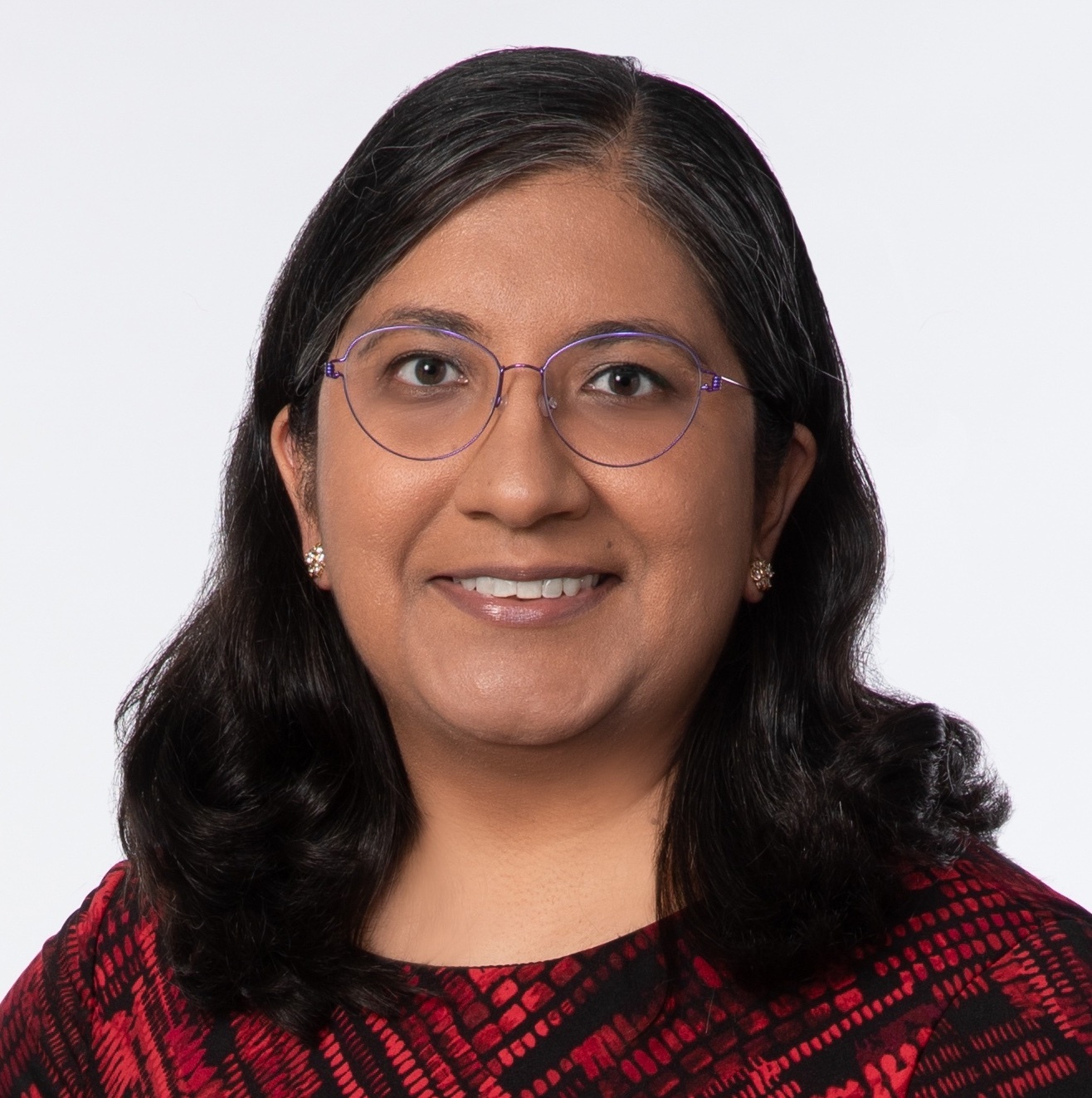
Nita Madhav leads the Epidemiology, Modeling, & Global Risk Analytics team at Ginkgo Biosecurity. Previously, Nita served as Chief Executive Officer at Metabiota, a company that specialized in measuring, mitigating, and managing epidemic risk. Nita has over 18 years of experience in probabilistic modeling and risk assessment. The majority of her experience has focused on monitoring and modeling infectious disease spread and economic impacts to provide actionable insights to commercial entities, governments, and multilateral organizations. Before becoming CEO, Nita was the Vice President of Data Science at Metabiota, where she established and led the data science and modeling group. Before joining Metabiota, Nita worked as a Principal Scientist at AIR Worldwide, where she led the life and health research and modeling team. Prior to that, Nita performed hantavirus research at the Special Pathogens Branch of the US Centers for Disease Control and Prevention. Nita holds a BS in Ecology & Evolutionary Biology, with distinction, from Yale University and an MSPH in Epidemiology from the Rollins School of Public Health at Emory University.
Credits
Hosted and written by Maggie Fox
Special guest: Nita Madhav
Produced and edited by Samantha Serrano
Music composed and sound edited by Raquel Krügel



